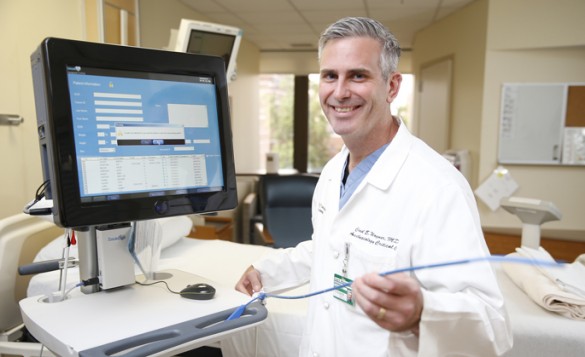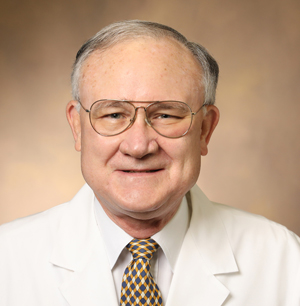
Vanderbilt Heart and Vascular Institute physicians are taking advantage of new technology in critical care that allows them to quickly visualize the patient’s heart at the bedside.
Hemodynamic transesophageal echocardiography (hTEE) uses a miniature, disposable echo probe to manage patients over an extended period of time. It is most beneficial to intensive care unit physicians as they care for advanced heart failure patients, said Chad Wagner, M.D., assistant professor of Clinical Anesthesiology and director of the cardiovascular intensive care unit.
The hTEE management device provides direct visualization of right ventricular function following surgery, reducing the occurrence of unnecessary re-operations and facilitating better management of complications, thereby lowering ICU costs, Wagner said.
“We are leading the nation in using this new technology,” he said, adding that hTEE is being used by cardiac surgeons, heart failure cardiologists and cardiac intensivists.
The purpose of bringing this technology to the ICU is to directly visualize a patient’s cardiac function at the bedside whenever the physician needs to do so. Previously, this in-depth look at the heart would take place in an echo lab outside of the ICU setting or required bringing the equipment to the ICU, which worked well for diagnostic purposes but was not practical for hemodynamic management.
“I think it allows us to quickly answer questions about ventricular function and correlate our impressions with real-time images,” said Simon Maltais, M.D., assistant professor of Surgery and surgical director of heart transplantation and mechanical support devices.
“We rely on experience and sometimes unreliable hemodynamic monitoring in complicated situations where we are trying to understand a problem. The hTEE approach is a valuable tool to continuously view the heart by just turning the device on. It adds an important piece of information and allows us to make proper decisions.”
The echo probe is inserted into the patient’s esophagus while he or she is sedated and intubated. It can be left in place for up to 72 hours and is portable so it can be used on several patients at one time.
Vanderbilt has used the hTEE probe on more than 250 patients, including 50 left ventricular assist device (LVAD) patients.
“We are finding the most utility in advanced heart failure patients,” Wagner said. “We’ve always used echo in the OR and use it continuously to watch the patient’s heart. When they come out of the OR, we really had no way to episodically monitor the heart with echo. The hTEE approach allows us to watch the right heart over time and helps us take better care of the LVAD patients when they are really sick.”
Wagner and Maltais are conducting ongoing research on the cost and outcomes of using hTEE, and report that the use of the probe has changed the management of care in 60 percent of patients.
Their findings were reported in the Journal of Cardiothoracic and Vascular Anesthesia.
The hTEE system is manufactured by ImaCor Inc.















